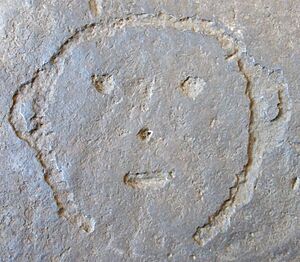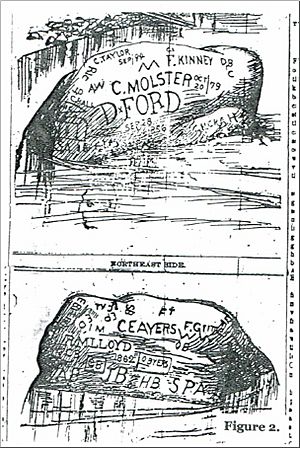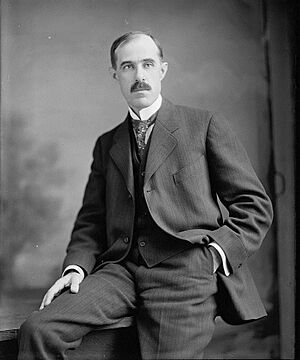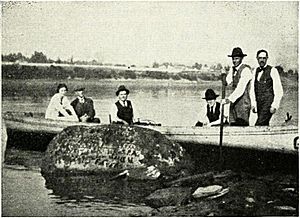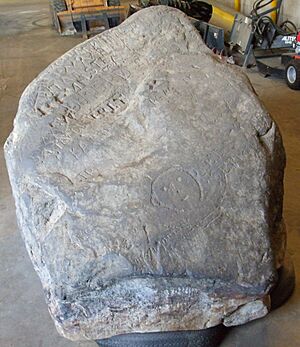Indian Head Rock facts for kids
Quick facts for kids Indian Head Rock |
|
|---|---|
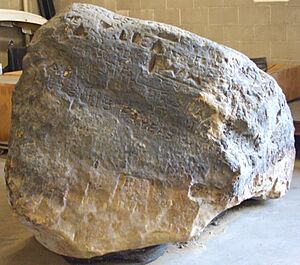
Indian Head Rock in 2007, stored in municipal garage, Portsmouth, Ohio
|
|
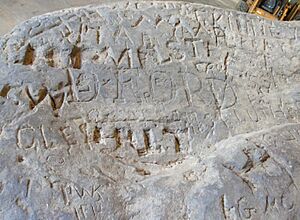 |
|
| Material | Sandstone |
| Size | 8.0 feet (2.4 m) long by 4.8 feet (1.5 m) wide by 5.0 feet (1.5 m) high |
| Writing | Names and initials carved in 1800s and early 1900s |
| Discovered | 2007 Ohio River (Kentucky side) opposite Portsmouth, Ohio, River mile 355.3 38°43′31″N 82°59′35″W / 38.72528°N 82.99306°W |
| Discovered by | Steve Shaffer |
| Present location | Rotary Park, South Shore, Kentucky 38°43′14″N 82°57′26″W / 38.72056°N 82.95722°W |
| Identification | 15 GP 173 |
| Indian Head Rock Project (Morehead State University) http://scholarworks.moreheadstate.edu/indian_head_rock/ |
|
The Indian Head Rock is a huge, eight-ton sandstone boulder. For a long time, it rested at the bottom of the Ohio River. In September 2007, a group of local divers, led by Steve Shaffer, brought it to the surface. People in Ohio and Kentucky had heard stories about this rock since the 1800s. Its recovery was a big event!
Officials in Portsmouth, Ohio wanted to display the rock to protect this historic treasure. However, a disagreement started between Ohio and Kentucky about who owned the rock. This led to some legal issues, but they were solved in 2010, and the rock was returned to Kentucky. For a while, it was kept in a county garage. Now, it's on display in a park. The story of the rock's recovery and the dispute is even featured in a 2017 documentary called "Between the Rock and the Commonwealth."
Contents
What's in a Name? The Indian Head Rock
The name Indian Head Rock comes from a carving on the bottom of the boulder. This carving looks like a human face. People have different ideas about who carved it. Some think it was a Native American artist who made a petroglyph (a carving on a rock). Others believe a boatman carved it to measure the river's water level. Another idea is that a man named John Book from Portsmouth, Ohio carved it. There are also theories that robbers used it to mark a hidden treasure, or that a quarry worker carved the face.
The first time the rock was mentioned by name was in a book from 1848. It said the rock was known as the "Indian's Head" and was used to tell how low the river was. If the water reached the top of the head, it meant the river was very low.
Newspapers in the 1800s called it the Indian Head. In the early 1900s, it was sometimes called Indian Rock. People also called it the Portsmouth Indian Head Rock because of its connection to Portsmouth and to avoid confusion with other rocks named "Indian Head."
The Rock's Long History
How the Rock Formed
The Indian Head Rock came from a landslide on the Kentucky hillside across from Portsmouth. It's made of hard sandstone. An old story from 1891 suggested the rock rolled down the hill a very long time ago. It also said the face might have been carved to remember the lowest water level ever seen in the Ohio River. Even back then, the rock already had many old names and symbols carved into it.
Over time, the river's flow made the rock's rough surfaces smooth. A newspaper in 1908 said the rock was "smooth as a bowling ball." It also mentioned that river histories from as early as 1811 talked about the rock.
The 1800s: A River Gauge
The Indian Head Rock was first used to measure the Ohio River's water level. A local resident kept a log, noting the river's height based on different parts of the rock, like the mouth, eyes, or top of the carving. For example, in 1851, the log noted the "eyes to be seen" meant the lowest water level since 1839.
In 1851, a Portsmouth newspaper reported that the river was very low, just three inches from the Indian Head. The story said pioneers carved the head to mark low water.
In 1891, the rock was almost completely visible. People could see its "backbone" sticking out of the water. Even when it was underwater, the water was so clear that carvings could be seen two feet below the surface. Many people went out in boats to see the "historic and mysterious rock."
In 1894, a drawing of the Indian Head Rock appeared in a Portsmouth newspaper. It showed initials, last names, and a small house carved on the rock. Many of these carvings are still there today. The drawing showed the rock near the Kentucky shore, with the "Indian Head" face just below the water.
The 1900s: Hidden by Dams
In 1908, the Ohio River was unusually low, allowing many people to visit the Indian Head Rock. The Portsmouth Daily Times reported that over 1,000 people saw the rock on one Sunday. Another Sunday, 1,500 people visited it. Many photos were taken, and some were even made into postcards.
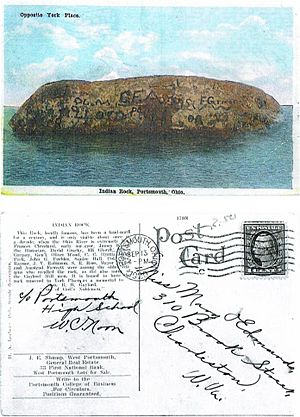
Henry Lorberg's Idea
The low water in 1908 gave Henry A. Lorberg, a local historian, an idea. He wanted to remove the rock from the river and display it in a park in Portsmouth. He thought it would be a good way to preserve the "historic boulder." Lorberg also believed the carving was done by John Book in the 1830s. However, Lorberg's plan to move the rock never happened.
Between 1875 and 1929, the U.S. Army Corps of Engineers built a series of dams on the Ohio River. These dams made the river level permanently higher. Lock and Dam No. 31, near Portsmouth, was finished in 1917. This meant the Indian Head Rock was now always underwater. It was only seen briefly in 1920 due to damage to the dam.
Congressman Henry T. Bannon's Visit
In October 1920, a steamboat damaged Dam No. 31, and the Ohio River's water level dropped very low. This was the first and only time the Indian Head Rock was seen since the dam was built, until its recovery in 2007. Henry T. Bannon, a lawyer and former U.S. Congressman from Portsmouth, became interested. The carved face was still underwater, so Bannon and his brother, Arthur, came up with a clever plan to photograph it.
They used a motorboat to create waves that would temporarily pull the water away from the rock. This allowed them to quickly take a picture of the carving. It took several tries to get a good photo. Bannon's paper, published in a historical journal, described new inscriptions on the rock. He thought that the rock and its carving might never be seen again. The photos they took were published with his paper.
Many other local residents also visited the rock in October 1920. The Portsmouth Daily Times reported that "Hundreds of Portsmouth people Sunday took advantage of an opportunity to view the famous Indian Rock."
In 2009, Henry T. Bannon's grandson shared a story. In the 1890s, when the river was low, new initials (HB, AB, and JB) appeared on the rock. Judge James Bannon realized his sons, Henry, Arthur, and Jim, were responsible. He told them not to admit it publicly. These initials are still visible on the rock today.
After 1920, the Indian Head Rock remained hidden underwater until it was brought up in 2007.
The Rock's Journey in the 21st Century
Bringing the Indian Head Rock to Light
Steve Shaffer, an amateur historian from Ironton, Ohio, was very interested in ancient rock carvings. He had read about the Indian Head Rock in sixth grade and researched its history as an adult. In 2000, he started looking for the rock with a team of divers. They found and photographed it in 2002.
By 2007, Shaffer had a team ready to recover the rock. They used inflatable air bags to lift the rock and float it to shore. A large crane then pulled it out of the water on September 9. A cheering crowd watched the event, which was covered by local news. Shaffer said his team wanted to preserve the rock and put it on public display for future generations.
On September 20, 2008, over 1,000 people attended a public event celebrating the rock's recovery. People gathered at the Portsmouth city garage to learn about the rock's history. Students from local schools attended, and a college scholarship was given to the winner of an essay contest.
The Ownership Dispute
The State of Kentucky claimed ownership of the Indian Head Rock. This was because the rock was found on the Kentucky side of the Ohio River. Also, the rock was listed in Kentucky's records of ancient objects. Because of this claim, Kentucky officials believed that Steve Shaffer's removal of the rock might have gone against Kentucky's Antiquity Act. This law protects historical items.
This led to a disagreement between Kentucky and Ohio. In January 2008, a Kentucky representative introduced a resolution asking Portsmouth, Ohio, to return the rock to its original spot in the river. This resolution was approved. The Kentucky Native American Heritage Council also asked for the rock to be returned to the river.
In response, Ohio representatives introduced their own resolution in May 2008. It stated that the Portsmouth Indian Head Rock was deeply connected to Portsmouth, Ohio's history. It also asked Kentucky to drop its ownership claims and work with Ohio to care for and display the rock.
Solving the Problem
In July 2009, Kentucky officials decided to drop the legal claims against Shaffer and the divers. They explained that there might have been more than one "Indian Head Rock" in the river, causing confusion about which one was officially registered. They said they couldn't prove beyond a doubt that the rock Shaffer found was the exact one listed in Kentucky's records.
On July 8, 2010, a settlement was reached. The rock was allowed to be brought to Kentucky and stored there. On November 4, 2010, the rock was returned to Kentucky. It was decided that the rock would not go back into the river because its original location had been changed.
Where is the Indian Head Rock Now?
For several years, the Indian Head Rock was stored in a county garage in Greenup County, Kentucky. A reporter who saw it in 2015 described it as "eight tons of sandstone surrounded by worn-out tractor tires and crusted with four years worth of cobwebs and grit." It was too big and heavy to move easily, and officials weren't sure where to put it.
In April 2019, Greenup County officials announced plans to display the rock in a park in South Shore, Kentucky. They planned to build a covered platform for it. Officials were concerned that the rock's sandstone surface was becoming fragile. They also wanted to make sure the rock would be protected from damage.
In September 2020, the Indian Head Rock was finally placed on public display at a park in South Shore, Kentucky. It is now on a covered platform and protected by a fence.
The Documentary: Between the Rock and the Commonwealth
Steven Middleton, a filmmaker and instructor at Morehead State University, learned about the dispute over the Indian Head Rock. He decided to make a film about it. Middleton believes that the rock should be easily seen by the public. His film, "Between the Rock and the Commonwealth," was finished in 2017. It has been shown on public television stations in Kentucky and Ohio.


